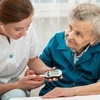
Older diabetics may sometimes do too good a job at keeping their blood sugar down, according to a new study.
Regardless of age, people with diabetes are taught to keep their blood sugar below certain target levels. But many diabetics over 65 who have other health concerns may be at risk for pushing it too low, according to a new study.
Particularly for older adults with multiple serious illnesses and functional limitations, the risks of low blood sugar, or hypoglycaemia, may outweigh the benefits of tight blood sugar control, the authors write.
"Older people are more susceptible to hypoglycaemia," said lead author Dr. Kasia J. Lipska of the Yale School of Medicine in New Haven, Connecticut.
"As people age, their kidney function deteriorates and drugs (like insulin) may not be eliminated from the body as efficiently," which can lead to low blood sugar, she told Reuters Health by email.
Often, people with low blood sugar don't realize they have it. Symptoms can include double or blurry vision, rapid heartbeat, headache, hunger, shaking or trembling, sweating, tiredness or weakness or feeling faint, trouble sleeping, unclear thinking, and other problems. Severe low blood sugar can cause seizures and brain damage.
Read: Hypoglycaemia and what to do about it
Intense treatment increases hypoglycaemia risk
Intense diabetes treatment, which the study showed many older people are doing, increases the risk for hypoglycaemia two to three fold, Lipska said.
Her team used data on 1,288 diabetics age 65 or older, from the National Health and Nutrition Examination Surveys from 2001 through 2010.
Based on their ability to complete activities of daily life, about half of the participants were generally healthy, 28 percent had "complex or intermediate" health and 21 percent had "poor" health.
To see how tightly these patients were controlling their blood sugar, the researchers measured a substance in the blood called haemoglobin A1c. A1c reflects a person's average blood sugar levels over the past three months.
A person without diabetes would have an A1C reading under 5.7 percent. People with pre-diabetes may have a reading between 5.7 and 6.4 percent. Levels above that qualify for a diabetes diagnosis.
Read: Do you have pre-diabetes?
A1C below 7% could be dangerous
Most people with diabetes aim to keep the number under 7 percent, according to the National Institutes of Health.
Almost two-thirds of the older adults in the study maintained tight blood sugar control, keeping their A1C levels at 7 percent or lower, according to results in JAMA Internal Medicine.
"Tight blood sugar control, or aiming for a haemoglobin A1c below 7 percent, increases the risk for hypoglycaemia, or low blood sugar reactions," Lipska said.
She and her coauthors did not assess how many people are actually harmed by diabetes over-treatment.
"We tried in our study to estimate how many people are treated in a way that is unlikely to benefit them and more likely to harm them, but we do not have data on follow-up to see what exactly happened to them," she said.
A 2011 study in the Journal of the American Geriatrics Society found that more than three million older people with diabetes would be eligible for reduction in medication if glucose targets were raised.
"It is not clear to me if doctors do enough to assess the burden of medications with their patients or know about hypoglycaemic events," said Dr. Elbert Huang of The University of Chicago, coauthor of the 2011 study.
"There is likely to be inadequate communication," he told Reuters Health by email.
Read: Treatment plan: type 2 diabetes
Ignorance may be driving over-treatment
Hypoglycaemia is a well-known consequence of tight blood sugar control, but its importance has been minimised largely due to pharmaceutical interests in keeping patients on anti-diabetic drugs, according to Dr. David Aron of the Louis Stokes VA Medical Centre in Cleveland, Ohio.
"I think this is actually a case of willful ignorance," Aron told Reuters Health by phone.
Hypoglycaemia is a major cause of emergency room visits, he said. The symptoms can be subtle, and older people may have trouble recognizing them, Aron said.
Though the healthcare system has been slow to act on the hypoglycaemia problem, there are a number of education initiatives aimed at clinicians and patients currently underway or planned for the near future, he said.
Diabetes treatment should be tailored to each individual patient, taking into account their age, other health conditions and preferences - the exact A1C target will vary, Lipska said.
Patients should ask their doctors what the right target is for them, she said.
"Think about what your health goals are and discuss these with your doctor," Lipska said. "You have to be as informed as possible about these decisions, and comfortable that the decisions are right for you.
Read more:
Poverty makes diabetes care tougher
Technology lightens the burden of diabetes
Symptoms of diabetes
Image: Elderly diabetic man measuring sugar level in blood using glucometer from Shutterstock




 Publications
Publications
 Partners
Partners















